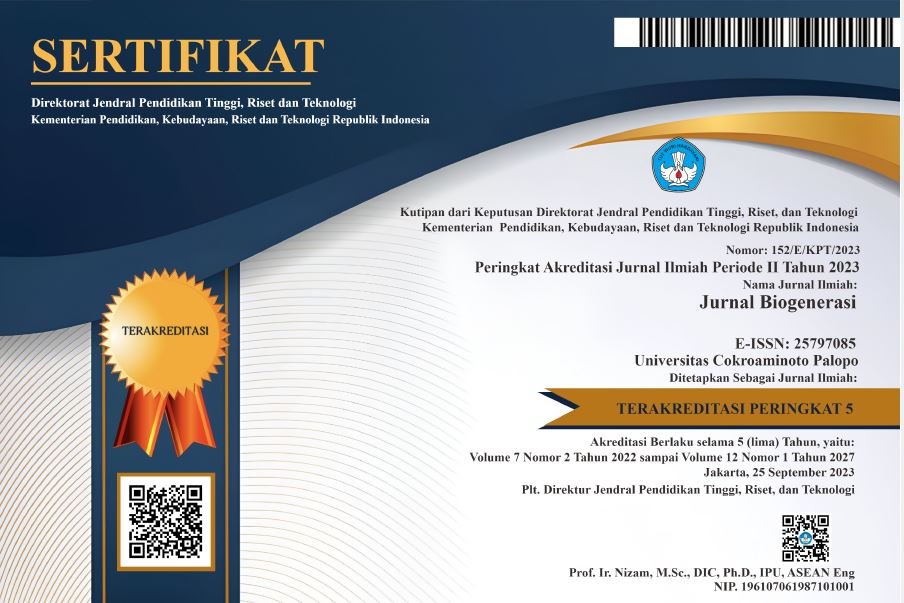Fitoremediasi Menggunakan Kangkung Air (Ipomoea aquatica) untuk Mengurangi Kadar Logam Berat dalam Limbah Cair Pabrik Tahu
DOI:
https://doi.org/10.30605/biogenerasi.v9i2.4755Keywords:
Phytoremediation, Ipomoea aquatica, Sewage, Heavy MetalsAbstract
The tofu industry produces waste in its processing process in the form of solid and liquid waste. One alternative to liquid waste treatment that can be used is the phytoremediation method. Phytoremediation system is a wastewater treatment technique using aquatic plants to help reduce organic substances contained in wastewater. This study aims to determine the effectiveness of water spinach (Ipomoea aquatica) in reducing heavy metal levels in tofu factory wastewater. This research method is experimental research on tofu factory wastewater with the research design used is pretest-posttest with control group. Based on the research obtained water spinach (Ipomoea aquatica) effective in reducing heavy metal levels in tofu liquid waste is evident from the lower TDS levels shown in the treatment using water spinach plants (Ipomoea aquatica) with a concentration of 25% of 1,503 ppm with the length of time required for 6 days.
Downloads
References
Ahmad, H., & Adiningsih, R. (2019). Efektivitas metode fitoremediasi menggunakan tanaman eceng gondok dan kangkung air dalam menurunkan kadar bod dan tss pada limbah cair industri tahu. Jurnal Farmasetis, 8(2), 31-38.
Aris, B. S., Rudi, R., & Lasarido, L. (2021). Pengelolaan limbah industri tahu menggunakan berbagai jenis tanaman dengan metode fitoremediasi. Agrifor: Jurnal Ilmu Pertanian dan Kehutanan, 20(2), 257-264.
Badriyah, L., Junaedi, A. S., & Zainuri, M. (2023). PENGARUH PEMBERIAN PROBIOTIK DAN KANGKUNG AIR (Ipomoea aquatica Forsk) TERHADAP PENURUNAN AMONIA LIMBAH BUDIDAYA LELE SANGKURIANG (Clarias gariepinus). In Seminar Nasional Multi Disiplin Ilmu Universitas Asahan (Vol. 1, pp. 311-317).
Hapsari, J. E., Amri, C., & Suyanto, A. (2018). Efektivitas kangkung air (Ipomoea aquatica) sebagai fitoremediasi dalam menurunkan kadar timbal (Pb) air limbah batik. Sanitasi: Jurnal Kesehatan Lingkungan, 9(4), 172-177.
Hasan, Z., Andriani, Y., Dhahiyat, Y., Sahidin, A., & Rubiansyah, M. R. 2017. Growth of different strains of three fishes and water spinach (Ipomoea reptans Poir) based aquaponic. Jurnal Iktiologi Indonesia, 17(2), 175-184.
HM, E. I. R., & Setiawati, T. C. (2023). Perbaikan beberapa karakteristik limbah cair tahu menggunakan variasi jumlah tanaman kangkung (Ipomoea aquatica) dan tanaman kiambang (Pistia stratiotes). Berkala Ilmiah Pertanian, 6(1), 8-12.
Indrawati, R. (2024). Efektivitas Tanaman Kangkung Air (Ipomoea aquatica) Dan Tapak Dara Air (Ludwigia adscendens) Sebagai Fitoremediator Pada Air Sungai Tercemar Limbah Cair Tahu
Maslinda, M., & Sedionoto, B. (2022). Efektifitas Tanaman Kangkung Air (Ipomoea Aquatica) Dalam Menurunkan Kadar Amonia Pada Limbah Cair Pabrik Tahu Di Lok Bahu Samarinda. In Prosiding Seminar Nasional Kesehatan Masyarakat Universitas Muhammadiyah Pontianak (Vol. 1, No. 1, pp. 34-43).
Nur, F. (2013). Fitoremediasi logam berat kadmium (Cd). Biogenesis: Jurnal Ilmiah Biologi, 1(1), 74-83.
Patmawati, I. Y. (2022). BIOREMEDIASI ANAEROB-AEROB LIMBAH CAIR TAHU. CV Literasi Nusantara Abadi.
Putri, A. A., Permana, F. G., Wulandari, A., & Irawanto, R. (2023). Respon Pertumbuhan Ipomoea Reptans Pada Media Tanam (Tanah dan Air) Terhadap Pencemar Timbal (Pb) Dan Tembaga (Cu). Prosiding Sains Nasional dan Teknologi, 13(1), 14-24.
Ratnani, R. D. (2012). Kecepatan Penyerapan Zat Organik Pada Limbah Cair Industri Tahu Dengan Lumpur Aktif. Jurnal Ilmiah Momentum, 7(2).
Roifa, A. M., Laili, S., & Lisminingsih, R. D. (2024). Pengukuran Total Dissolved Solid (TDS), Oksigen Terlarut (DO) dan pH Dalam Fitoremediasi Limbah Laundry Dengan Tanaman Kangkung Air Ipomoea aquatica. Jurnal Ilmiah Mahasiswa Sains Unisma Malang, 2(1), 1-6.
Sugiyono. (2018). Metode Penelitian Kuantitatif, Kualitatif, dan R&D. Bandung: Alfabeta. Google Scholar
Downloads
Published
How to Cite
Issue
Section
License
In submitting the manuscript to the journal, the authors certify that:
- They are authorized by their co-authors to enter into these arrangements.
- The work described has not been formally published before, except in the form of an abstract or as part of a published lecture, review, thesis, or overlay journal.
- That it is not under consideration for publication elsewhere,
- That its publication has been approved by all the author(s) and by the responsible authorities – tacitly or explicitly – of the institutes where the work has been carried out.
- They secure the right to reproduce any material that has already been published or copyrighted elsewhere.
- They agree to the following license and copyright agreement.
License and Copyright Agreement
Authors who publish with this journal agree to the following terms:
- Authors retain copyright and grant the journal right of first publication with the work simultaneously licensed under Creative Commons Attribution License (CC BY 4.0) that allows others to share the work with an acknowledgment of the work's authorship and initial publication in this journal.
- Authors are able to enter into separate, additional contractual arrangements for the non-exclusive distribution of the journal's published version of the work (e.g., post it to an institutional repository or publish it in a book), with an acknowledgment of its initial publication in this journal.
- Authors are permitted and encouraged to post their work online (e.g., in institutional repositories or on their website) prior to and during the submission process, as it can lead to productive exchanges, as well as earlier and greater citation of published work.


.png)

